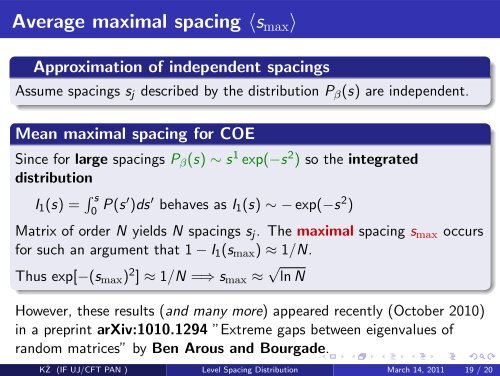Level Spacing Distribution Revisited - Theoretical Group Atomic ...
Level Spacing Distribution Revisited - Theoretical Group Atomic ... Level Spacing Distribution Revisited - Theoretical Group Atomic ...
Average maximal spacing 〈smax〉 Approximation of independent spacings Assume spacings sj described by the distribution Pβ(s) are independent. Mean maximal spacing for COE Since for large spacings Pβ(s) ∼ s 1 exp(−s 2 ) so the integrated distribution I1(s) = s 0 P(s′ )ds ′ behaves as I1(s) ∼ −exp(−s 2 ) Matrix of order N yields N spacings sj. The maximal spacing smax occurs for such an argument that 1 − I1(smax) ≈ 1/N. Thus exp[−(smax) 2 ] ≈ 1/N =⇒ smax ≈ √ lnN However, these results (and many more) appeared recently (October 2010) in a preprint arXiv:1010.1294 ”Extreme gaps between eigenvalues of random matrices” by Ben Arous and Bourgade. K ˙Z (IF UJ/CFT PAN ) Level Spacing Distribution March 14, 2011 19 / 20
Concluding Remarks Random Matrices: a) offer a useful tool applicable in several branches of science including physics ! b) display (asymptotically) universal properties, which depend on the symmetry with respect to orthogonal / unitary / symplectic transformations Limit N → ∞ corresponds to the semiclassical limit of quantum theory or geometric optics as a limiting case of wave optics! Problem of extremal eigenvalues is described by Tracy–Widom distributions. The analogous problem of extremal spacings is studied only recently Preliminary results on spectral statistics of local unitary evolution operators (with tensor product structure). K ˙Z (IF UJ/CFT PAN ) Level Spacing Distribution March 14, 2011 20 / 20
- Page 1 and 2: Level Spacing Distribution Revisite
- Page 3 and 4: Random Matrices & Universality Univ
- Page 5 and 6: Wigner Semicircle Law Spectral dens
- Page 7 and 8: Extremal eigenvalues & Tracy-Widom
- Page 9 and 10: Some applications of Tracy-Widom La
- Page 11 and 12: Random Domino & Arctic Circle Theor
- Page 13 and 14: Level spacing distribution P(s) Nea
- Page 15 and 16: Level spacing for unitary matrices
- Page 17 and 18: Minimal spacing P(smin) for N = 4 u
- Page 19: Average maximal spacing 〈smax〉
Average maximal spacing 〈smax〉<br />
Approximation of independent spacings<br />
Assume spacings sj described by the distribution Pβ(s) are independent.<br />
Mean maximal spacing for COE<br />
Since for large spacings Pβ(s) ∼ s 1 exp(−s 2 ) so the integrated<br />
distribution<br />
I1(s) = s<br />
0 P(s′ )ds ′ behaves as I1(s) ∼ −exp(−s 2 )<br />
Matrix of order N yields N spacings sj. The maximal spacing smax occurs<br />
for such an argument that 1 − I1(smax) ≈ 1/N.<br />
Thus exp[−(smax) 2 ] ≈ 1/N =⇒ smax ≈ √ lnN<br />
However, these results (and many more) appeared recently (October 2010)<br />
in a preprint arXiv:1010.1294 ”Extreme gaps between eigenvalues of<br />
random matrices” by Ben Arous and Bourgade.<br />
K ˙Z (IF UJ/CFT PAN ) <strong>Level</strong> <strong>Spacing</strong> <strong>Distribution</strong> March 14, 2011 19 / 20



